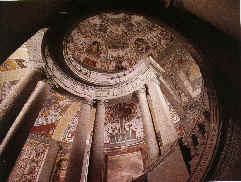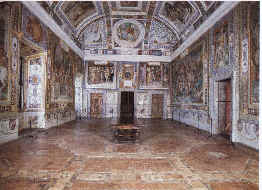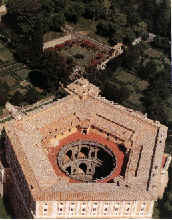|
|
THE PALAZZO FARNESE AT CAPRAROLA
The
Villa Farnese deserves a special place among the great works of art of the late
Renaissance. It is the wonderful achievement of a brilliant architect who did
his best to pay homage to his rich patronís liberality. In the 16th
century, Cardinal Alessandro Farnese Junior, pope Paul IIIís grandson,
commissioned Jacopo Barozzi da Vignola to design a wonderful villa. The rich and
powerful churchman wanted to get away from the problems of city life, so he
decided to make Caprarola his home. Situated on a hilltop near
Lake Vico , the small town served well the cardinalís
purpose, as it was a quiet and safe place. The Villa is a pentagon-shaped
building with a circular interior courtyard. The Palazzo had already been
started on a pentagonal plan by Antonio da Sangallo the Younger, an expert
military engineer. Work on it was interrupted around the mid-16th
century; however, the walls of the fortress had already been erected at that
time. After Sangalloís death, Vignola began to work at Caprarola around the
mid sixteenth century. He decided to keep the pentagonal shape intact, and
designed an elegant palazzo with hundreds of rooms and a beautiful Italian
garden. The villa Farnese is a five-storey building with a rock-cut cellar and
several kitchens. It houses the Stanze dei Prelati with splendid frescoes, the
Piani dei Cavalieri e degli Staffieri and the Piano Nobile with the cardinalís
private apartments and some gorgeous public rooms. In the 16th
century the Farnese family were at the top of their power, and the rich cardinal
engaged some famous artists to decorate his villa. Among them were Taddeo and
Federico Zuccari, two clever artists whose pictorial style recalls some
excellent early Renaissance painters such as Michelangelo, Raphael and Giorgio
Vasari. The frescoes of the Piano Nobile show historical episodes, legends and
events taken from the Holy Scriptures. When Vignola died in 1573, work on villa
was still under way. The project was carried out by some clever architects. The
most famous one is Jacopo del Duca, who completed the Palazzo and designed the
Palazzina del Piacere, a small lodge in a big park near the Villa. Used as a
summer residence by Alessandro Farnese and his successors, the lodge has a
geometric garden with some fine fountains and peperino statues.
Fonte
dati e immagini APT Viterbo |
||||||||||||||||||||||||||


